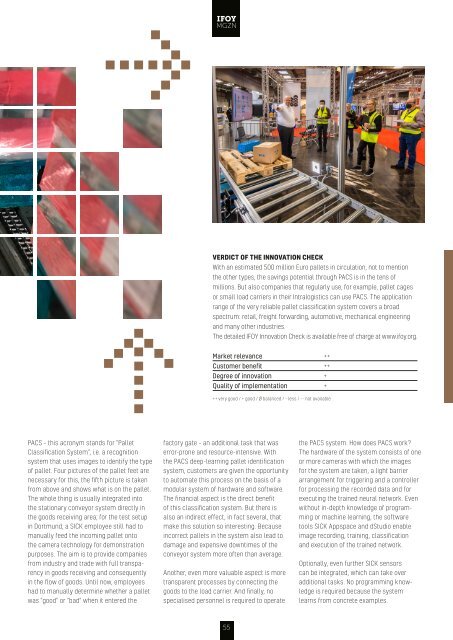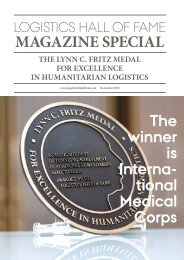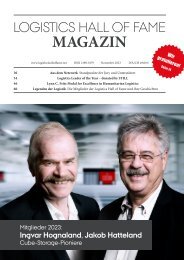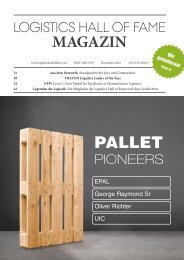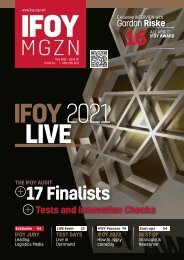IFOY MGZN 2022 EN
You also want an ePaper? Increase the reach of your titles
YUMPU automatically turns print PDFs into web optimized ePapers that Google loves.
<strong>IFOY</strong><br />
<strong>MGZN</strong><br />
VERDICT OF THE INNOVATION CHECK<br />
With an estimated 500 million Euro pallets in circulation, not to mention<br />
the other types, the savings potential through PACS is in the tens of<br />
millions. But also companies that regularly use, for example, pallet cages<br />
or small load carriers in their Intralogistics can use PACS. The application<br />
range of the very reliable pallet classification system covers a broad<br />
spectrum: retail, freight forwarding, automotive, mechanical engineering<br />
and many other industries.<br />
The detailed <strong>IFOY</strong> Innovation Check is available free of charge at www.ifoy.org.<br />
Market relevance ++<br />
Customer benefit ++<br />
Degree of innovation +<br />
Quality of implementation +<br />
++ very good / + good / Ø balanced / - less / -- not available<br />
PACS – this acronym stands for "Pallet<br />
Classification System", i.e. a recognition<br />
system that uses images to identify the type<br />
of pallet. Four pictures of the pallet feet are<br />
necessary for this, the fifth picture is taken<br />
from above and shows what is on the pallet.<br />
The whole thing is usually integrated into<br />
the stationary conveyor system directly in<br />
the goods receiving area; for the test setup<br />
in Dortmund, a SICK employee still had to<br />
manually feed the incoming pallet onto<br />
the camera technology for demonstration<br />
purposes. The aim is to provide companies<br />
from industry and trade with full transparency<br />
in goods receiving and consequently<br />
in the flow of goods. Until now, employees<br />
had to manually determine whether a pallet<br />
was "good" or "bad" when it entered the<br />
factory gate – an additional task that was<br />
error-prone and resource-intensive. With<br />
the PACS deep-learning pallet identification<br />
system, customers are given the opportunity<br />
to automate this process on the basis of a<br />
modular system of hardware and software.<br />
The financial aspect is the direct benefit<br />
of this classification system. But there is<br />
also an indirect effect, in fact several, that<br />
make this solution so interesting. Because<br />
incorrect pallets in the system also lead to<br />
damage and expensive downtimes of the<br />
conveyor system more often than average.<br />
Another, even more valuable aspect is more<br />
transparent processes by connecting the<br />
goods to the load carrier. And finally, no<br />
specialised personnel is required to operate<br />
the PACS system. How does PACS work?<br />
The hardware of the system consists of one<br />
or more cameras with which the images<br />
for the system are taken, a light barrier<br />
arrangement for triggering and a controller<br />
for processing the recorded data and for<br />
executing the trained neural network. Even<br />
without in-depth knowledge of programming<br />
or machine learning, the software<br />
tools SICK Appspace and dStudio enable<br />
image recording, training, classification<br />
and execution of the trained network.<br />
Optionally, even further SICK sensors<br />
can be integrated, which can take over<br />
additional tasks. No programming knowledge<br />
is required because the system<br />
learns from concrete examples.<br />
55


